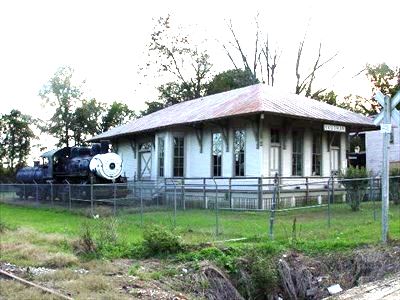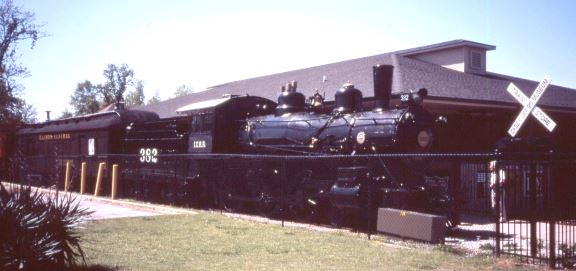A Railroad Man
by Joseph N Goodell
North of Madison, past the Nissan plant and Canton through the thickening forest, Exit 133 directed me east to Vaughan, Mississippi. The brief drive along Vaughan Road is picturesque under a canopy of trees, past a few well-tended homesteads. I stopped at the sharp left turn where abandoned railroad tracks and tank car TCBX 231183 lay just ahead over an earthen mound with tangled perma-growth.
Barely visible to my right, in winter, that is, without the total shrouding by summer’s vines, weeds and shrubs lay the site of a once elegant replica of a railway station (still intact in 2007) made up as a Casey Jones museum. Next door the ruins of a post office/general store suggested the Vaughan which was. In 1900 a busy community with the depot and post office, stores, cotton gin, homes, and 100 or so people. (Some of whom retained the quaint yet “healthful” custom of eating bits of dirt found years later to be a source of streptomycin.)

Proceeding north, through dense forest, cleared occasionally for corn and beans, then along US 51 towards Pickens from MS 432, I was still looking for that elusive museum. The library staff in Pickens was hospitable and bright, but beyond a dated internet look-up, meaningful information was as slim as the name of the town itself. Perhaps further north through Goodman (early home of David Donald, the masterful author of “Lincoln”) and Durant to the West.
I could not help but notice along the way, and despair about, the stretches of track and tank cars (too many to count), festooned with vines and clearly abandoned, like corroded beads on a long discarded necklace. But then at West, aha, a fairly well maintained, but closed railway station labeled “Casey Jones Welcome Center,” and “Illinois Central Depot and Casey Jones Museum,” enhanced by a few tankers and hoppers on the adjacent track.
Needing to learn more, I visited a forlorn general store, the small but tidy bank, the post office, city hall, police department, and library all sparsely staffed and cautiously receptive. Their collective information, released reluctantly if not dismissively and with disinterest, yielded merely that the museum is open in September for the annual West Festival. Plus some guarded mumbling of maybe IC reopening the track which “y’all know is now closed ‘tween Canton ‘n’ Gr’nada.” (Called variously Illinois Central, Grenada RR or Canadian National.) Just as sparse were a few artifacts, presumably related to Casey, which I could glimpse through the museum’s dusty windows. (Better Casey background I’ve gleaned from a cordial interview with Frank Patty of Yazoo City and his well selected portfolio.)
According to a few MDOT releases since 2015, this line, currently held by Iowa Pacific Holdings, is planned for eventual return to service. There is some funding, but the benefit of routing freight directly south from Grenada to Canton and beyond, vital in 1900, I felt must now be weighed against the millions of 21st Century dollars to do so.
In April of 1900 the Grenada-Canton run was indeed busy. Accounts differ in detail, but engineer “Casey” Jones and his fireman Simeon Webb were filling in for Sam Tate, taken ill, the night of April 29–30 for the return run from Memphis to Canton. They had just arrived in Memphis when ordered to “double-back,” allowed a short rest and scheduled out at 11:35 pm, but then delayed to 12:50 am. Theirs was a fast engine, No. 382 with a light passenger train of six cars, the “Cannonball Express,” ideal for making up the lost time despite rain, fog, and tricky curves.
Achieving speeds over eighty mph through Senatobia and Sardis, they arrived in Grenada having made up nearly an hour. Onward through Winona and Durant, there was glee in the cab: “Sim, the old girl’s got her dancing slippers on tonight.” Leaving Goodman slightly behind schedule, with a good chance of reaching Canton by 4:05 am as “advertised.”
But there was confusion and congestion at Vaughan, information which Casey should have received in West. Two freights, #72 heading north, and southbound #83 were too long for the passing track and four cars of #83 extended onto the main line. And there they stayed, unable to move due to a broken air hose on #72.
Almost on schedule at 75 mph through Pickens towards Vaughan, just six miles ahead, was a long left-hand turn blocking their view until, too late, when Sim, then Casey, could see the red lights on the obstruction just across Tucker Creek.
“Jump, Sim, jump,” shouted Jones to Webb over a long piercing whistle and squealing air brakes. Somewhere between 35 and 50 mph No. 382 struck the caboose, a car loaded with hay, one with corn, and one with timber of #83 before leaving the track early the morning of April 30th.
By staying on the brakes it is believed that Casey limited overturns to his engine thereby saving his passengers, but sacrificing himself, the only fatality. He was carried home to Jackson, TN (where there is a proper museum) for funeral services at St Mary’s Church and Mt Calvary Cemetery.

(A terse official position statement by Illinois Central bent the cause back to engineer Jones as solely responsible for the wreck: “He had failed to heed warnings, never responding to flag signals.”)
The event surged in the annals of American legend after Casey’s friend, “engine wiper” Wallace Saunders composed a ten-verse ballad, “Casey Jones.” It became popular on the vaudeville circuit which, according to legend, brought Wallace a pint of gin for the rights to his song. That relationship and the up-beat good cheer which Casey maintained among railroad men in general. Noted too for his reputation of running on time and lengthy trademark whip-poor-will locomotive whistle.
Born John, or Johnathan or Jonathon Luther Jones in 1863, living in Cayce, KY, he was working for the railroads by the time his family moved to Jackson. He qualified as engineer in February 1890, operating special trains and gaining enough seniority for promotion to passenger from freight trains.
The final few miles for Casey’s “Cannonball Express” from Vaughan to Canton were completed by the newly appointed #1, its passengers, perhaps of one mind, and sobered by the tragedy as was Wallace Saunders in his closing verse:
Headaches and heartaches and all kinds of pain
Are not apart from a railroad train
Tales that are earnest, noble and grand
Belong to the life of a railroad man.”
****************************************************************************
Joseph N Goodell Madison, MS


